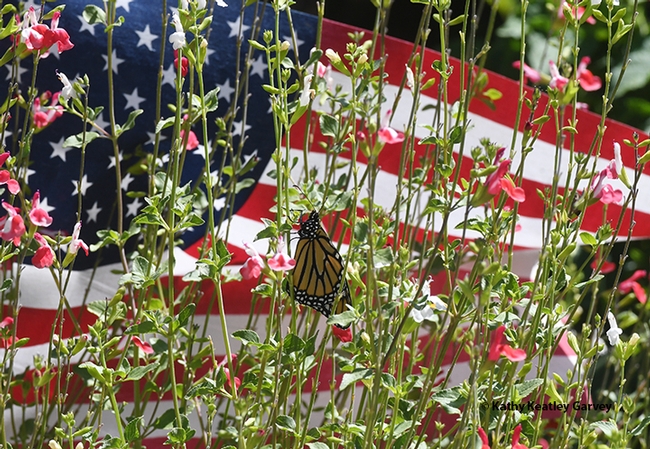- Author: Kathy Keatley Garvey
"What are YOU doing here?"
It was Saturday morning, Jan. 23, and the monarch caterpillar seemed to be sunning itself on a milkweed leaf in our family's pollinator garden in Vacaville, Calif., a Solano County city situated between San Francisco and Sacramento.
Yes, Saturday, Jan. 23. The dead of winter. A third-star monarch caterpillar.
"Mama Monarch" must have laid the egg in late December, surmised butterfly guru Art Shapiro, UC Davis distinguished professor of evolution and ecology, who has researched butterfly population trends since 1972 and maintains a research website, Art's Butterfly World.
"Evidence of inland winter breeding," he commented. "Nothing surprises me any more..."
Interestingly enough, on the same day that we spotted the monarch caterpillar was the same day that naturalist-photographer Greg Kareofelas, an associate of the Bohart Museum of Entomology, UC Davis, photographed a newly eclosed Gulf Fritillary, Agraulis vanillae, in his yard in Davis.
The temperature on Jan. 23 hovered at 60 degrees. Since then, it's dropped into the 30s, with blustery winds, heavy rain and a strong storm uprooting trees and flash-flooding the LNU Lighting Complex burn scar. And it's c-o-l-d--cold enough to borrow Bernie Sanders' heavy overcoat and mittens, and for good measure, add an Elmer Fudd (trapper) hat, the kind you need in Vermont.
But a monarch caterpillar in January in Solano County?
Last year the monarchs in our garden thrived, as the Danaus plexippus population declined throughout the country, and scientists began talking about extinction. Last year we collected more than 300 monarch eggs or caterpillars in our garden, primarily from two of the three milkweed species. We reared and released them, except for the ones we donated to researchers at the University of California, Davis and the University of Nevada to start their own colonies.
Is the January caterpillar healthy? Will it survive?
Seems so. We moved it inside on Jan. 24 in a Bohart Museum butterfly habitat on our kitchen counter, but only time will tell.
Still, it's like spotting the Easter Bunny handing out candy in December or Santa Claus delivering candy canes on Easter Sunday.
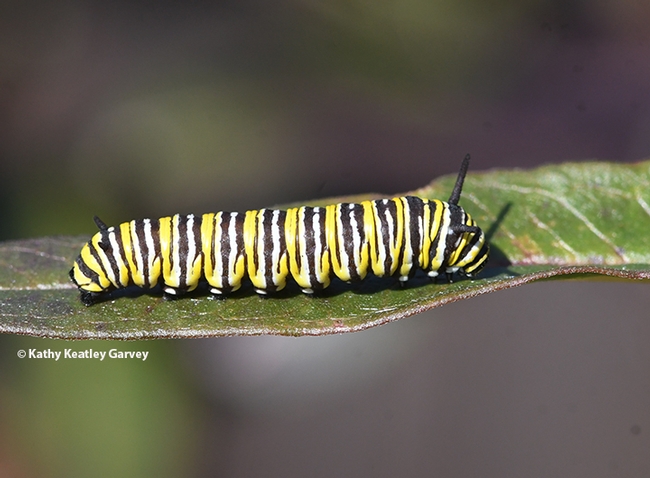
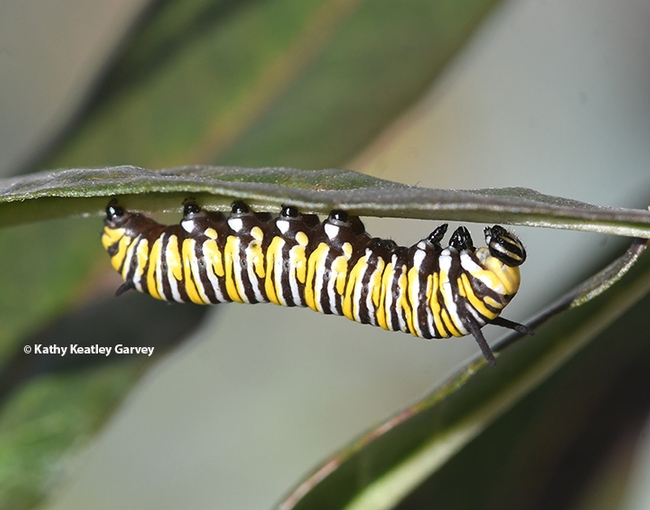
- Author: Kathy Keatley Garvey
Christmas morning and the sights are bright.
Santa came in his sleigh last night.
He came with a whoosh and a ho-ho-ho.
He came with a monarch and a no-no-no.
"Don't let them get extinct," he said with a shout.
And that's what endangered species are all about.
(Read what the Xerces Society of Invertebrate Conservation wants you to do to help save the monarch, Danaus plexippus, from extinction)
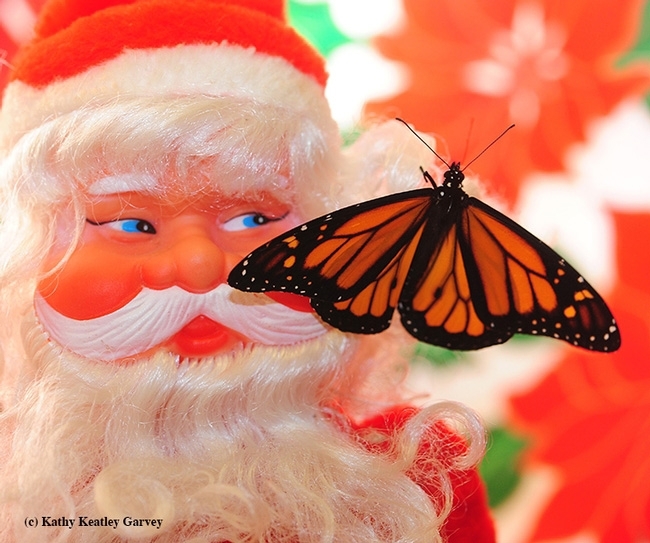
- Author: Kathy Keatley Garvey
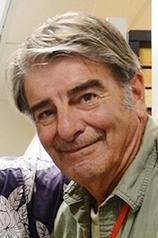
Usually the life cycle--from egg to caterpillar to chrysalis to adult—takes about a month, but this one took only 24.5 days.
“She was in a hurry,” said Kareofelas, an associate at the Bohart Museum of Entomology, University of California, Davis, and a retired finance director of the UC Davis School of Medicine.
The egg hatched in 3.5 days. The caterpillar formed a chrysalis 12.5 days later. The monarch emerged or eclosed 8.5 days later. And it took only two hours—usually it's around four—for her to dry her wings and fly away.
“You're Ruth,” Kareofelas told her as she dried her wings on Sept. 19. “You're alive. You're going to fly.”
Kareofelas decided to name her Ruth that morning, 24 hours after the death of Supreme Court Justice Ruth Bader Ginsburg, a champion of gender equality and women's rights.
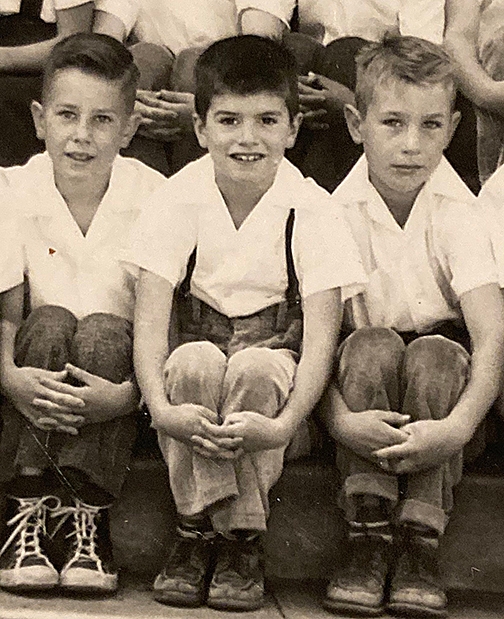
“I just happened to see her laying an egg on my milkweed,” he said.
Kareofelas documented the life stages on his Facebook page, daily educating his readers about the iconic butterfly, and posting photos that he captured with his “point-and-shoot camera,” a pocket-sized Canon SB890IS.
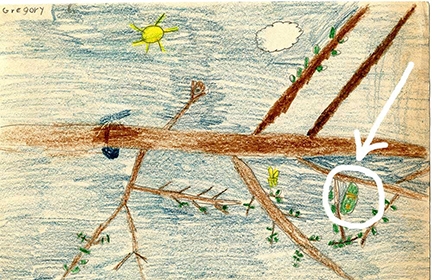
Kareofelas photographed her limp wings slowly expanding and “hardening.”
“In the wild, the butterfly is very vulnerable at this stage,” he said. “It cannot fly.”
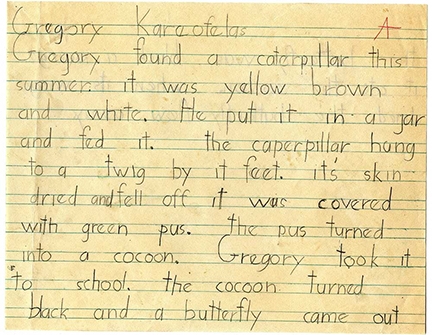
Like her namesake, Ruth the Monarch showed independence, determination and drive.
“So, at 10 this morning (Sept. 19), I took her outside and released her,” Kareofelas wrote on Facebook. “She immediately flew to the top of the plum tree and from there, off she went. Goodbye, Ruth, stay strong and come back next spring.”
He's hoping she'll make it to the overwintering grounds along coastal California and return in February.
Childhood Interest
Kareofelas first became interested in butterflies in 1951, when as a second-grader at the Holy Rosary Academy, Woodland, he wrote and illustrated a butterfly booklet.
“Luckily, I had the kind of mother that saved this booklet,” Greg said, noting that was almost 70 years ago. “We did not know the name monarch, but you can see that I described a monarch caterpillar, chrysalis and adult butterfly. The drawing shows a green chrysalis, even showing a golden band.”
“There was no one guiding me--neither Mom nor Dad was versed in anything nature, but they were very supportive,” Greg recalled. He read the children's book, “Golden Guide to Insects,” and later borrowed a copy of John Henry Comstock's “How to Know the Butterflies” from the Yolo County Library. “The irony is most of what was in those two books was more for the East Coast, rather than California.”
Kareofelas went on to study business administration at Sacramento State College, serve in the U.S. Army (Korea USS Pueblo Crisis 1968-69) and then accepted a position at the UC Davis School of Medicine. “So, nothing butterfly related there.”
Kareofelas renewed his interest in butterflies in the 1970s when he visited the Bohart Museum of Entomology, named for Professor Richard Bohart and “run by Bob Schuster.” Then located in Briggs Hall, Kleiber Hall Drive, the Bohart Museum is now housed in the Academic Surge Building on Crocker Lane. UC Davis entomology professor Lynn Kimsey, a former graduate student of Bohart's, directs the museum, which includes a global collection of nearly 8 million insect specimens, plus a live “petting zoo”(Madagascar hissing cockroaches, walking sticks and tarantulas) and a gift shop.
Kareofelas, a member of the Lepidopterists Society, is always eager to learn and share insect information. He confers with butterfly guru Art Shapiro, UC Davis distinguished professor of evolution and ecology (who hasn't seen a monarch egg or caterpillar all year), and serves as a volunteer at the Bohart Museum, where at special events, he shows butterfly and moth specimens with Lepidoptera curator Jeff Smith.
The Davis resident has led educational trips for Sutter Buttes Foundation, California Native Plant Society, Jepson Prairie Preserve, and the Placer Land Trust. He and UC Davis-trained entomologist Fran Keller, now a professor at Folsom Lake College, teamed to spotlight the California dogface butterfly on posters and in a book, “The Story of the Dogface Butterfly.” Kareofelas continues to lead tours of the Placer Land Trust's dogface butterfly habitat near Auburn.
“I am lucky to have been able to get to know some incredible folks—the Bohart crew and Shapiro—and through the Lepidopterists Society,” Kareofelas said.
Ruth the Monarch is lucky, too. She could have been a meal for a spider, a lady beetle or a milkweed bug, or parasitized by a tachinid fly or wasp.
Didn't happen.
“You're Ruth. You're alive. You're going to fly.”
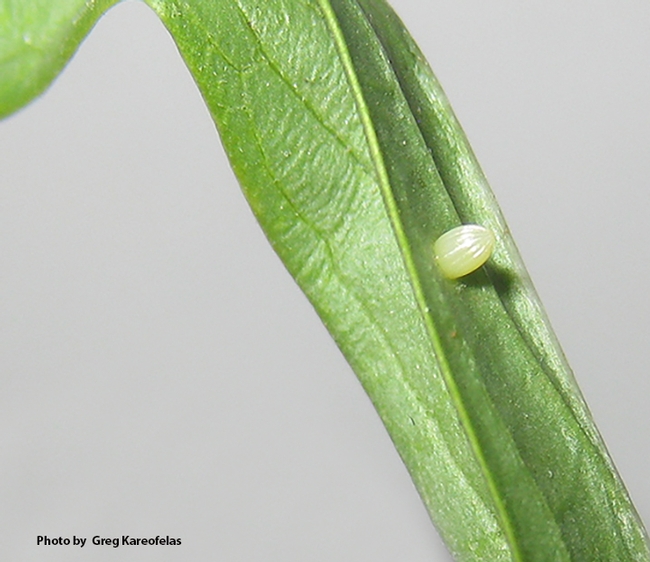
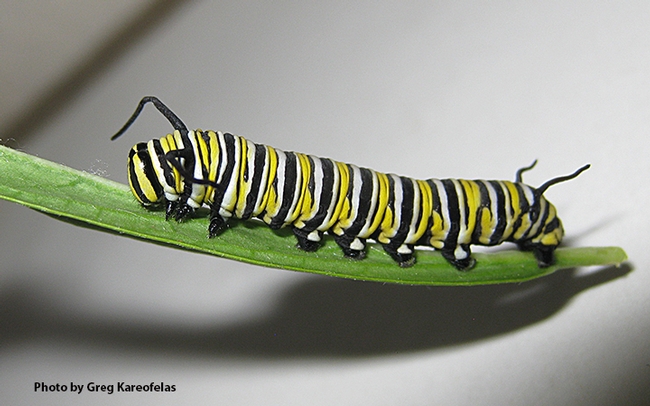
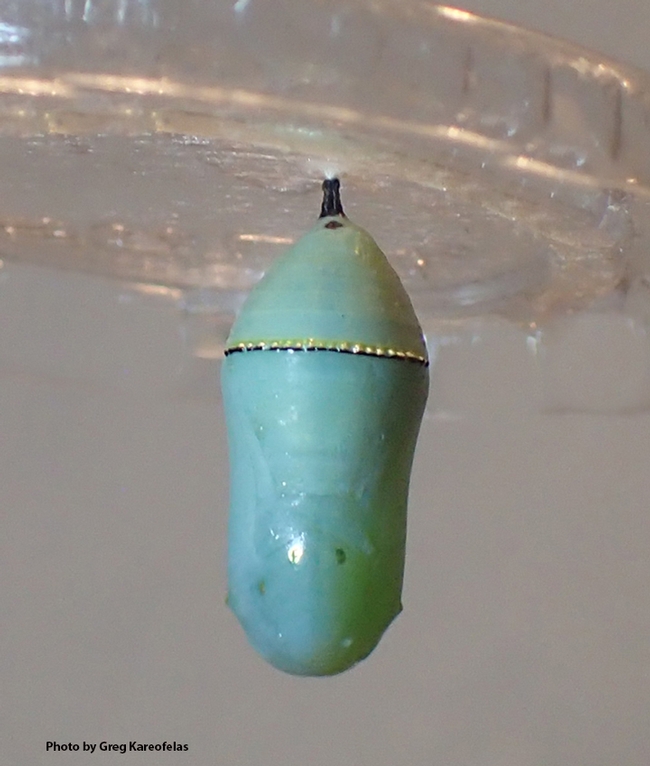
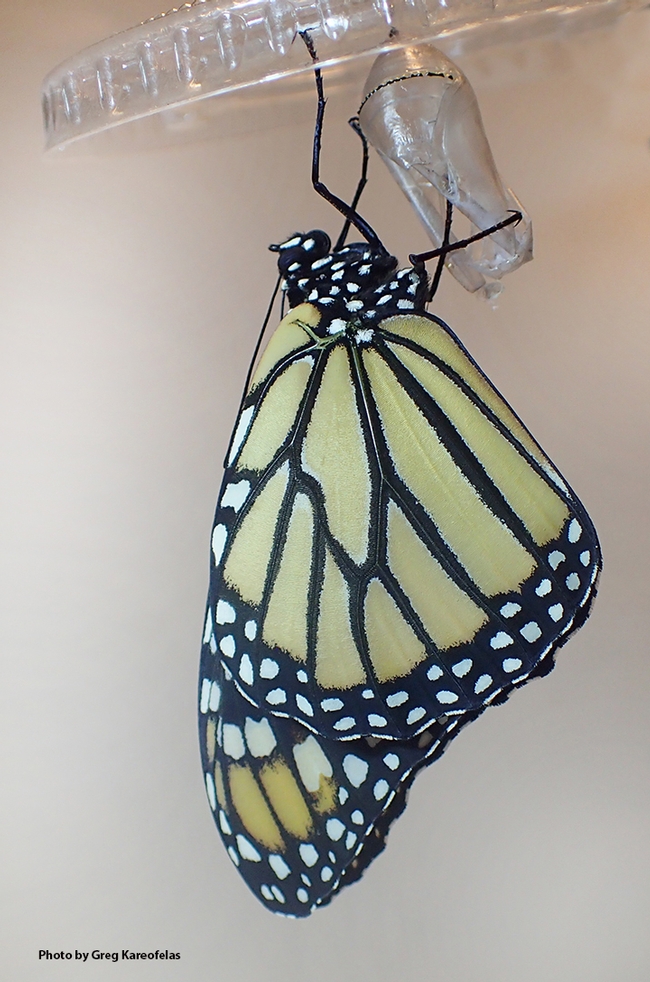
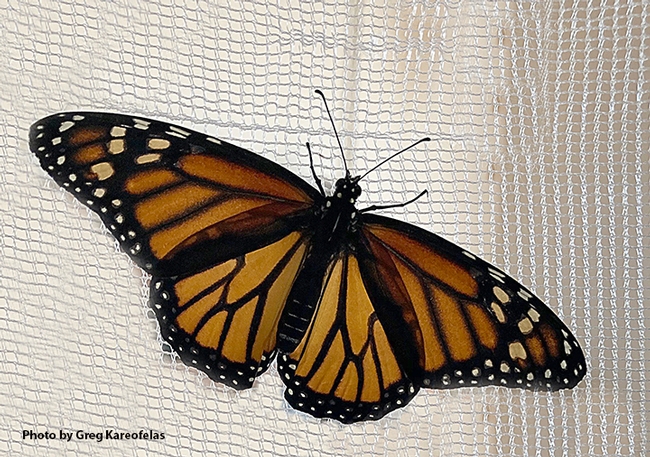
- Author: Kathy Keatley Garvey
Ever seen a back-lit monarch butterfly?
It's like a stained-glass window in a centuries-old steepled church where you cannot see the ugliness of the world, but its beauty.
Monarchs are like that. Those iconic butterflies excite, inspire and transform you, just like stained glass windows.
We captured these images at dusk of a monarch fluttering around an aphid-infested milkweed, a tropical milkweed, Asclepias curassavica, on Aug. 7 in Vacaville, Calif.
The orange butterfly was nothing but a blur until we stopped the action (1/4000 of a second) with a 200mm macro lens mounted on a Nikon D500.
The beauty (the monarch) eclipsed the beast (oleander aphids) in a moment of time.
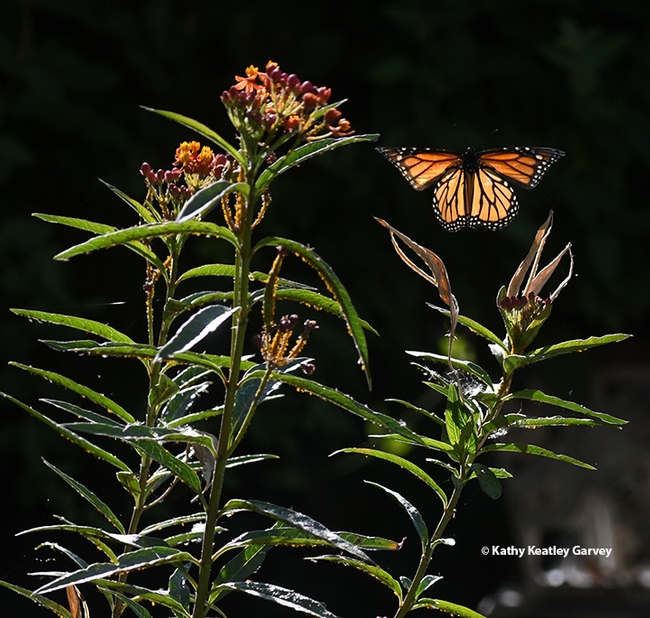
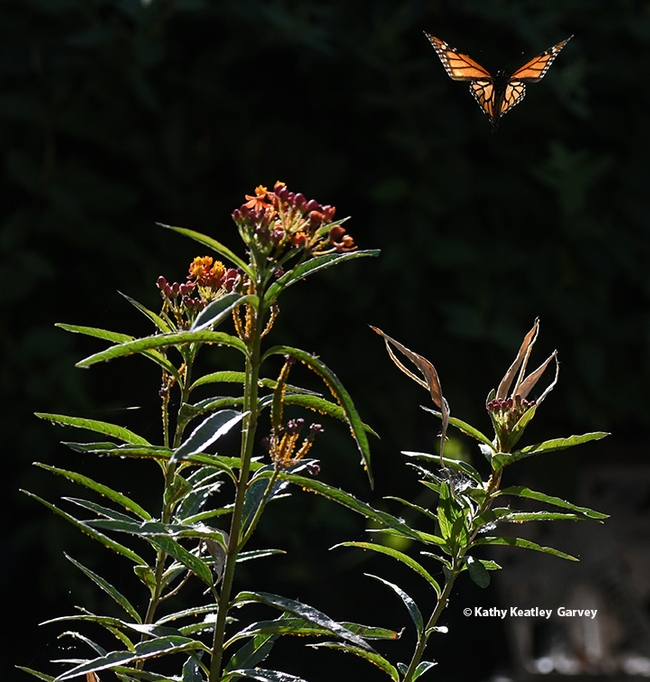
- Author: Kathy Keatley Garvey
We call it the Fourth of July or Independence Day.
Our 13 American colonies rose up against the monarch of Great Britain, King George III, and declared themselves free and independent.
This weekend, no thanks to the coronavirus pandemic, we won't celebrate with fireworks, parades, picnics, family reunions or baseball games, but we will give thanks to the 13 colonies who gave us our freedom from a troubling monarch.
Today we watched a different kind of monarch, a monarch butterfly, Danaus plexippus, gain her freedom as she eclossed from her chrysalis.
From an egg to a caterpillar to a chrysalis to an adult..."Welcome to the world, Ms. Monarch."
But first, let Ms. Monarch cling to the Hot Lips salvia, Salvia microphylla, and dry those wings. Let her watch the honey bees, carpenter bees, cabbage white butterflies, Gulf Fritillaries, damselflies, and syrphid flies forage. Let her react when they buzz, bounce or bump into her. Beware of that praying mantis!
She will know when she's had enough...just like the 13 colonies knew when enough was enough and King George III lost his American colonies.
